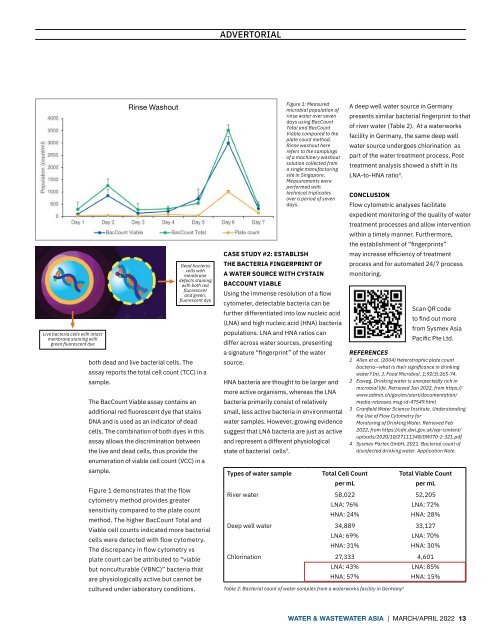Water & Wastewater Asia March/April 2022
Water & Wastewater Asia is an expert source of industry information, cementing its position as an indispensable tool for trade professionals in the water and wastewater industry. As the most reliable publication in the region, industry experts turn this premium journal for credible journalism and exclusive insight provided by fellow industry professionals. Water & Wastewater Asia incorporates the official newsletter of the Singapore Water Association (SWA).
Water & Wastewater Asia is an expert source of industry information, cementing its position as an indispensable tool for trade professionals in the water and wastewater industry. As the most reliable publication in the region, industry experts turn this premium journal for credible journalism and exclusive insight provided by fellow industry professionals. Water & Wastewater Asia incorporates the official newsletter of the Singapore Water Association (SWA).
Create successful ePaper yourself
Turn your PDF publications into a flip-book with our unique Google optimized e-Paper software.
ADVERTORIAL<br />
Live bacteria cells with intact<br />
membrane staining with<br />
green fluorescent dye<br />
both dead and live bacterial cells. The<br />
assay reports the total cell count (TCC) in a<br />
sample.<br />
The BacCount Viable assay contains an<br />
additional red fluorescent dye that stains<br />
DNA and is used as an indicator of dead<br />
cells. The combination of both dyes in this<br />
assay allows the discrimination between<br />
the live and dead cells, thus provide the<br />
enumeration of viable cell count (VCC) in a<br />
sample.<br />
Rinse Washout<br />
Figure 1 demonstrates that the flow<br />
cytometry method provides greater<br />
sensitivity compared to the plate count<br />
method. The higher BacCount Total and<br />
Viable cell counts indicated more bacterial<br />
cells were detected with flow cytometry.<br />
The discrepancy in flow cytometry vs<br />
Dead bacteria<br />
cells with<br />
membrane<br />
defects staining<br />
with both red<br />
fluorescent<br />
and green,<br />
fluorescent dye<br />
plate count can be attributed to “viable<br />
but nonculturable (VBNC)” bacteria that<br />
are physiologically active but cannot be<br />
cultured under laboratory conditions.<br />
CASE STUDY #2: ESTABLISH<br />
THE BACTERIA FINGERPRINT OF<br />
A WATER SOURCE WITH CYSTAIN<br />
BACCOUNT VIABLE<br />
Using the immense resolution of a flow<br />
cytometer, detectable bacteria can be<br />
further differentiated into low nucleic acid<br />
(LNA) and high nucleic acid (HNA) bacteria<br />
populations. LNA and HNA ratios can<br />
differ across water sources, presenting<br />
a signature “fingerprint” of the water<br />
source.<br />
HNA bacteria are thought to be larger and<br />
more active organisms, whereas the LNA<br />
bacteria primarily consist of relatively<br />
small, less active bacteria in environmental<br />
water samples. However, growing evidence<br />
suggest that LNA bacteria are just as active<br />
and represent a different physiological<br />
state of bacterial cells 3 .<br />
Types of water sample<br />
Figure 1: Measured<br />
microbial population of<br />
rinse water over seven<br />
days using BacCount<br />
Total and BacCount<br />
Viable compared to the<br />
plate count method.<br />
Rinse washout here<br />
refers to the samplings<br />
of a machinery washout<br />
solution collected from<br />
a single manufacturing<br />
site in Singapore.<br />
Measurements were<br />
performed with<br />
technical triplicates<br />
over a period of seven<br />
days.<br />
A deep well water source in Germany<br />
presents similar bacterial fingerprint to that<br />
of river water (Table 2). At a waterworks<br />
facility in Germany, the same deep well<br />
water source undergoes chlorination as<br />
part of the water treatment process. Post<br />
treatment analysis showed a shift in its<br />
LNA-to-HNA ratio 4 .<br />
CONCLUSION<br />
Flow cytometric analyses facilitate<br />
expedient monitoring of the quality of water<br />
treatment processes and allow intervention<br />
within a timely manner. Furthermore,<br />
the establishment of “fingerprints”<br />
may increase efficiency of treatment<br />
process and for automated 24/7 process<br />
monitoring.<br />
Total Cell Count<br />
per mL<br />
River water 58,022<br />
LNA: 76%<br />
HNA: 24%<br />
Deep well water 34,889<br />
LNA: 69%<br />
HNA: 31%<br />
Chlorination 27,333<br />
LNA: 43%<br />
HNA: 57%<br />
Table 2: Bacterial count of water samples from a waterworks facility in Germany 4<br />
Scan QR code<br />
to find out more<br />
from Sysmex <strong>Asia</strong><br />
Pacific Pte Ltd.<br />
REFERENCES<br />
1 Allen et al. (2004) Heterotrophic plate count<br />
bacteria—what is their significance in drinking<br />
water? Int. J. Food Microbiol. 1;92(3):265-74.<br />
2 Eawag. Drinking water is unexpectedly rich in<br />
microbial life. Retrieved Jan <strong>2022</strong>, from https://<br />
www.admin.ch/gov/en/start/documentation/<br />
media-releases.msg-id-47549.html<br />
3 Cranfield <strong>Water</strong> Science Institute. Understanding<br />
the Use of Flow Cytometry for<br />
Monitoring of Drinking <strong>Water</strong>. Retrieved Feb<br />
<strong>2022</strong>, from https://cdn.dwi.gov.uk/wp-content/<br />
uploads/2020/10/27111348/DWI70-2-321.pdf<br />
4 Sysmex Partec GmbH, 2021. Bacterial count of<br />
disinfected drinking water. Application Note.<br />
Total Viable Count<br />
per mL<br />
52,205<br />
LNA: 72%<br />
HNA: 28%<br />
33,127<br />
LNA: 70%<br />
HNA: 30%<br />
4,601<br />
LNA: 85%<br />
HNA: 15%<br />
WATER & WASTEWATER ASIA | MARCH/APRIL <strong>2022</strong> 13


















